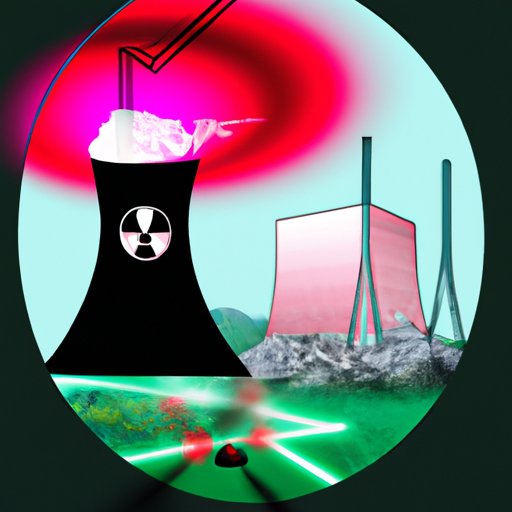Introduction
Nuclear technology is a form of energy production that utilizes radioactive materials to generate electricity. It is one of the most efficient forms of energy production available, but it also has the potential for significant environmental and health risks. In this article, we will explore the basics of nuclear technology, examine its history and development, investigate its impacts on society and the environment, and provide a beginner’s guide to nuclear power plants.
Exploring the Basics of Nuclear Technology: What is it and How Does it Work?
At its core, nuclear technology is a form of energy production that utilizes radioactive materials to generate electricity. This process is known as nuclear fission, which is the splitting of an atom’s nucleus into smaller nuclei. When the nuclei are split, they release energy in the form of heat, which is then used to generate electricity. There are several types of reactors used in nuclear power plants, including pressurized water reactors, boiling water reactors, and gas-cooled reactors.
The basic process of nuclear energy generation involves using uranium fuel rods to produce heat through nuclear fission. The heat produced is then used to heat up water, creating steam. The steam is then used to drive a turbine, which generates electricity. This electricity is then sent to the power grid and distributed to homes and businesses.
The Pros and Cons of Nuclear Technology
Nuclear technology has both advantages and disadvantages, which must be taken into consideration when weighing its use as an energy source. On the plus side, nuclear technology is highly efficient, with a single nuclear power plant capable of producing enough electricity to power millions of homes. Additionally, nuclear technology does not produce greenhouse gases, making it a more environmentally friendly option than some other forms of energy production.
On the downside, nuclear technology poses a risk of accidents due to the hazardous materials involved. Additionally, nuclear waste is extremely difficult to safely store and dispose of, posing a significant environmental risk. Finally, there is the potential for nuclear weapons proliferation, as the technology used to generate electricity can also be used to create weapons of mass destruction.
A Beginner’s Guide to Nuclear Power Plants
Nuclear power plants contain a variety of components, each of which plays an important role in the production of electricity. The reactor core houses the nuclear fuel rods, which are the source of the nuclear fission reaction. The containment building is a large steel structure designed to contain any radiation that might escape from the reactor. The cooling system circulates the heat generated by the reactor and transfers it to the steam generator, where the heat is used to create steam.
Safety measures are in place at all nuclear power plants to ensure the safety of those working at the plant and the surrounding community. These measures include regular inspections, emergency drills, and the use of protective equipment. Additionally, nuclear power plants must adhere to strict regulations set by the government to ensure the safe operation of the plant.
Common challenges faced by nuclear power plants include aging infrastructure, rising costs, and public opposition. As nuclear power plants age, their components may need to be replaced or upgraded, leading to increased costs. Additionally, the public may oppose the construction or operation of a nuclear power plant due to safety concerns.

Examining the History and Development of Nuclear Technology
The development of nuclear technology began in the early 20th century, when scientists first discovered the energy released by splitting atoms. Over the following decades, scientists and engineers worked to refine and improve the process of nuclear fission and develop the technology necessary to generate electricity. Major milestones in the advancement of nuclear technology include the first nuclear reactor built in 1942, the first commercial nuclear power plant opened in 1954, and the first nuclear fusion reactor built in 1991.
Looking ahead, the future prospects of nuclear technology are promising. Advances in technology have made nuclear power plants safer and more efficient, and new designs could be used to make them even more reliable and cost-effective. Additionally, research is being done on small modular reactors, which could be used to provide energy to remote locations or used as backup power sources for larger plants.

Investigating the Impact of Nuclear Technology on Society and the Environment
Nuclear technology has a range of impacts on society and the environment. Economically, nuclear power plants can provide jobs and generate tax revenue, while providing an affordable source of electricity. Environmentally, nuclear technology produces minimal air pollution and no greenhouse gases. However, there is still the potential for nuclear accidents, which could have devastating consequences for the environment.
Socially, nuclear technology has both positive and negative implications. On the one hand, it can provide a reliable source of electricity and reduce dependence on fossil fuels. On the other hand, there is the potential for public opposition to nuclear power plants due to safety concerns and the risk of nuclear proliferation.
Conclusion
In conclusion, nuclear technology is a form of energy production that utilizes radioactive materials to generate electricity. It is highly efficient and does not produce greenhouse gases, but it also poses a risk of accidents and nuclear waste disposal issues. We have examined the basics of nuclear technology, explored its history and development, and investigated its impacts on society and the environment. Ultimately, the decision to use nuclear technology as an energy source must take into account the potential risks and rewards.
(Note: Is this article not meeting your expectations? Do you have knowledge or insights to share? Unlock new opportunities and expand your reach by joining our authors team. Click Registration to join us and share your expertise with our readers.)
